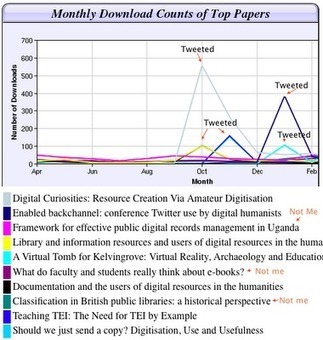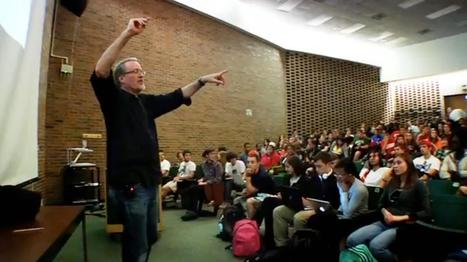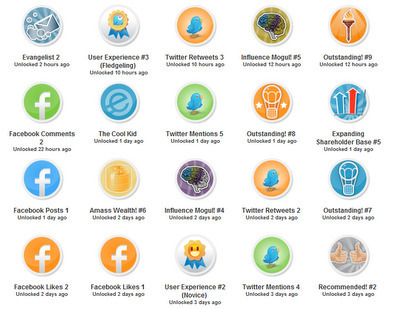 Your new post is loading...
 Your new post is loading...
Initiatives seek to give students permanent online records for skills they have developed that they could then use when applying to college or for jobs. KF: The badges approach is especially suited to more open education strategies and begins to recognise that there are sytill areas that do no require formal accreditation. I suspect the approach has a long way to go before mainstream adoption and will need to address some questions around "assurance of learning" if it is to be picked up more ubiquitiously. I can see there being a system whereby even your employer can award badges that help you map your learning from experience and training.
"Like many organisations, digital social technologies are greatly influencing the way we work in higher education. Dr Kelly Page, a lecturer in Digital Marketing, Cardiff Business School considers how, as a sector, we need to move forward.
Changes in digital social technologies are not just changing how we communicate, educate or research, they are changing the fundamental ways in which we work, learn and coexist.
When we teach in a lecture theatre for example, a member of the student community can (and does) record, edit and share the experience through social technologies via a smart phone. When we debate a new policy in a meeting the minutes are captured and shared as PDF documents or through a Google Doc. on the web. When we respond to student questions, the experience can be posted to a personal or group Facebook page by an attendee around which, further public discussion can occur. When we give a keynote address or present at a conference, comments from our talk appear on Twitter and are Google indexed."
Just because companies are using social media doesn’t mean they’re using it effectively, however. When asked to assess their progress on social media, the largest segment of respondents in the global survey, 29%, said they were “doing nothing,” while 27% said they were in the “first steps,” and 17% said they were in the “pilot phase.” By comparison, only 15% were “integrating social media” and a mere 12% had succeeded in integrating social media into an overall corporate strategy. In the U.S., 26% of companies said they were “doing nothing,” 24% said they were in the “first steps,” and 23% said they were in the pilot phase. Only 17% said they were in the process of integrating social media, and just 11% said it was fully integrated. In terms of purpose, 39% are using social media to help manage customer experience, 24% use it to manage customer conversations, 19% use it to manage content, and 16% use it for collaboration. Read more: http://www.mediapost.com/publications/article/177313/most-companies-failing-to-integrate-social-media.html?edition=48229#ixzz1yTV8wluW
Via Gary Hayes
As we grow into a more mature relationship with social media, we’ll find time to talk. There is a lot to figure out. By Sherry Turkle.
Via dirkvl
Social media tools can help create a more dynamic community of practice and provide an ongoing and searchable conversation to benefit others. To successfully introduce social media into a community of practice within an organization, there are several factors that need to be addressed and questions to be asked.
Facebook has been making many inroads into education over the last few years. Many institutions are using Facebook sites to publicize events on campus, as well as to aid in their recruiting.
As well, many students, instructors and administrators are using a number of Facebook applications for a wide variety of academic purposes.
I was intrigued to see the paper series about Student Motivation published by the U.S. Center on Education Policy shared as a resource on GETideas.org.
I have a standing policy...if your education facility uses Engage or The End of Business as Usual as a class textbook, I will stop by via skype or sometimes live to talk to your students and answer their questions.
Darrell West examines how new technologies such as blogs, social media, and video games improve education, and how schools and universities are using these tools to help students learn.
Eager to find out what impact blogging and social media could have on the dissemination of her work, Melissa Terras took all of her academic research, including papers that have been available online for years, to the web and found that her audience responded with a huge leap in interest in her work.
|
KF: From the blog of Timo Ilomäki (Teacher & Counselor, Project leader in iPads in High School). Part of a series related to Twitter, Tweetdeck and associated clients.
Via Ana Cristina Pratas
"Probably the hardest thing to “mimic” in online education is the experience of meeting peers and professors on campus. Besides making friendships and having the opportunity to directly interact with other people, working together on problems and learning with the help of peers is an important part of the entire experience."
I have a hard truth to share with you. Our learning management systems are letting us down. They are not getting the job done.
The slow rise of social learning Over the last decade, the internet has gone from a primarily static content distribution system, to a social publishing, communication and sharing environment. As we’ve seen this “social web” develop, several social learning theoretical frameworks have been developed and tested, including connectivism, social constructivism and the conversational framework. These pedagogical models of learning remain at the periphery and have yet to achieve mainstream adoption.
Educational Twitter hashtags plus a great infographic on Twitter.
Via Peter Mellow
More and more students have Twitter accounts now. Here are five ways I use Twitter in my lecture classes. Curtin Teaching and Learning: Staff at Curtin have access to the Hotseat tool that allows multi-faceted input to lectures including posting via Twitter, but can keep the discussion within the community of the class. Check http://cel.curtin.edu.au/learning_technologies/hotseat.cfm for more information.
Research on the Information Society, the Digital Divide and Information and Communication Technologies for development...
With allegations of inappropriate interactions between school staff and students on the rise -- and many of those interactions initiated on social media -- the city's Department of Education has issued new guidelines for online contact.
Empire Avenue is the new game in town.It sits squarely in the social networking space, but it has a different twist - one from which I think businesses may be able to gain valuable insights, all w...
Via Peter Mellow
View Kim Flintoff's professional profile on LinkedIn. LinkedIn is the world's largest business network, helping professionals like Kim Flintoff discover inside connections to recommended job candidates, industry experts, and business partners.
Following on from the lists of academic tweeters published earlier this month, we have put together a short guide to using Twitter in university research, teaching, and impact activities, available to download as a PDF or view on Issuu. How can Twitter, which limits users to 140 characters per tweet, have any relevance to universities and academia, where journal articles are 3,000 to 8,000 words long, and where books contain 80,000 words? Can anything of academic value ever be said in just 140 characters?
|



 Your new post is loading...
Your new post is loading...



























